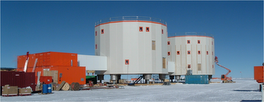CASE recovery started
The first station (CAS01 for those in the know) was easy enough, though we had the unpleasant surprise of finding that the acquisition system was off, and looked like it had been all year. We had measured all the parameters, tested all the batteries, and removed all the material, including the radio antenna, in under 2 hours.
High in spirits, we motored over to the second station (CAS03). Here we found the batteries to be unnormally warm (above plus 30 degrees Celsius), we think because of a poor connection between one of the solar panels and the regulator. The acquisition system was recording, and seemed to have nearly finished its disk space. At this station, we were supposed to recover the seismometer, a CMG40 that was part of a faulty batch, and that needed to be sent back to the supplier. Digging the seismometer out was an hour's work for two of the team, while the other two dealt with disconnecting, testing and reconnecting the batteries. We were also supposed to recover the seismometer cable, and that is where the trouble began. The cable ran 10 meters or so from seismometer to acquisition box, under 1.5 meters of packed and hardened snow. It took the 4 of us 2.5 hours to dig it out, advancing no more than 20 cm at a time, using nothing more than shovels and a saw... grueling!
Scientists are stubborn creatures, and the four of us proved that yesterday, by not giving up until the whole cable was out. If there is one thing that we will have learned from this experience, it is don't bury your cables too deep!
The whole mission lasted 9 hours, all spent at -35 degrees Celsius, with a wind-chill factor of something like -45 degrees, except for the 1.5 hours round trip time. Needless to say we were exhausted last night, and have spent most of today recovering. Recovery of the third station, originally planned for this morning, was unanimously delayed to Monday.





No comments:
Post a Comment